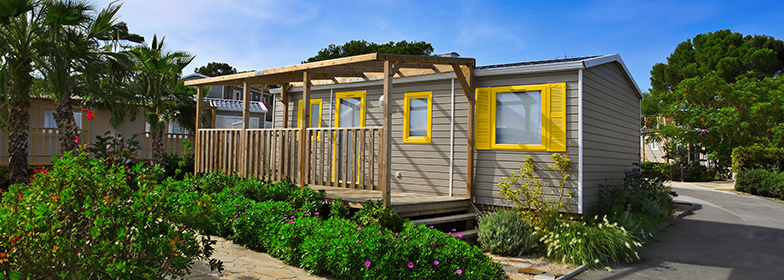
Modular vs. manufactured vs. mobile home—what’s the difference?
Modular, manufactured, and mobile homes differ in how they’re built and set up. Manufactured homes are made in factories, follow HUD standards and cost less than regular homes. Modular homes are also factory-made but follow local codes and sit on permanent foundations. Mobile homes are older, lightweight homes, designed to be easily moved.
If you’re interested in buying a manufactured home, you’re not alone. Many homebuyers consider manufactured housing to offset higher home prices.
Manufactured housing can offer a more affordable alternative to traditional homes without compromising quality, empowering more Americans to become homeowners. Recent estimates show that a new manufactured home may cost up to two-thirds less than a single-family house.
How to choose between a modular, manufactured or mobile home
Comparing key features can help you decide which type of home is right for you:
| Home type | Construction | Price | Quality | Customization | Appreciation | Loan type |
|---|---|---|---|---|---|---|
| Mobile home |
|
Generally more affordable | Can vary, often less durable | Limited customization options | Limited appreciation potential | Mobile home loans (typically have higher |
| Manufactured home |
|
Generally more affordable | High standards for quality and durability | More customization options than mobile homes but less than modular | Potential for appreciation, especially in desirable locations | Manufactured home loans, similar to traditional mortgages |
| Modular (or prefab) home |
|
Can be more expensive than manufactured but often less than a traditionally built home | High standards for quality and durability | High level of customization | Potential for appreciation, similar to traditional homes | Traditional mortgages |
Each home may require a different type of mortgage:
- Mobile: Securing a loan for a pre-1976 mobile home can be challenging, but specialized lenders, personal loans, or seller financing may be options.
- Manufactured: Manufactured home loans, which include CrossMods™, offer financing for single, double and triple-wide homes manufactured on or after June 15, 1976.
- Modular: Modular homes are considered stick-built homes and are eligible for traditional mortgage financing for one-unit properties.
Connect with a local loan officer and find out which loan program you may qualify for.
How to choose between modular, manufactured and mobile
Deciding between a modular, manufactured or mobile home depends on your budget, lifestyle and needs. Here are several factors to consider:
- Budget: Mobile and manufactured homes are generally the most affordable upfront. While often more expensive, modular homes offer greater customization and may appreciate in value more like homes built on the property.
- Location: Think about where you plan to place your home. A modular home typically requires a permanent foundation, whereas a manufactured home can be set on temporary or permanent bases, depending on your site.
- Lifestyle: For a long-term residence, a modular home provides durability and a traditional home feel. A manufactured home may be better for seasonal or budget-friendly living. A mobile home offers flexibility if you need to relocate.
- Long-term goals: If you plan to stay in the home for multiple years, a modular home, like a traditional home, has potential to be a good investment. Manufactured homes, while cost-effective, may have limited resale value, depending on demand.
Local zoning and building codes can also influence your options. Some areas restrict where manufactured or mobile homes can be placed, while modular homes may face fewer zoning hurdles. Always check local regulations and homeowner association rules before making a decision.
Getting a mortgage for a manufactured home
At Guild Mortgage, we offer financing for CrossMod™ homes through the FHLMC CHOICEHome and FNMA MH Advantage® programs. These programs create more affordable and innovative options for anyone interested in owning a manufactured home classfied as a CrossMod home. Requiring a down payment as low as 3 percent, the programs deliver significant cost savings with interest rates that are comparable to stick- built homes.
Manufactured homes that qualify for these programs can include custom amenities, like:
- Accessibility features: Ramps, wider doorways and grab bars
- Architectural design: Unique architectural styles and details
- Energy-efficient appliances: Energy-star rated refrigerators, dishwashers and more
- Garage: Attached or detached garage
- Outdoor living spaces: Decks, patios and outdoor kitchens
- Smart home technology: Smart security systems, thermostats and lighting
- Upgraded bathroom and kitchen: Modern fixtures, cabinetry and countertops
Eligible manufactured homes are identified by a “Mortgage Financing Notice,” also known as the “MH Advantage® Sticker” or the FHLMC CHOICEHome sticker. Having this sticker means that you—and anyone who buys your home in the future—will be eligible to finance with either program.
Along with FNMA MH Advantage® and FHLMC CHOICEHome, Guild provides other loans for manufactured homes, like:
- Conventional loan: Offers a 5 percent down payment requirement with a 620 credit score minimum.
- FHA loan: Offers a 3.5 percent down payment requirement with a lower 580 credit score minimum.
- USDA loan: Offers 100 percent financing with no down payment requirement for eligible rural properties though a slightly higher 640 credit score minimum.
- VA loan: Available to veterans, active-duty service members and eligible surviving spouses with no down payment requirement and a 620 credit score minimum.
Need help navigating your options?
Guild loan officers are local, knowledgeable and ready to help. If you’re trying to decide between a mobile, modular or manufactured home, let’s have a conversation.
The above information is for educational purposes only. All information, loan programs and interest rates are subject to change without notice. All loans subject to underwriter approval. Terms and conditions apply.
